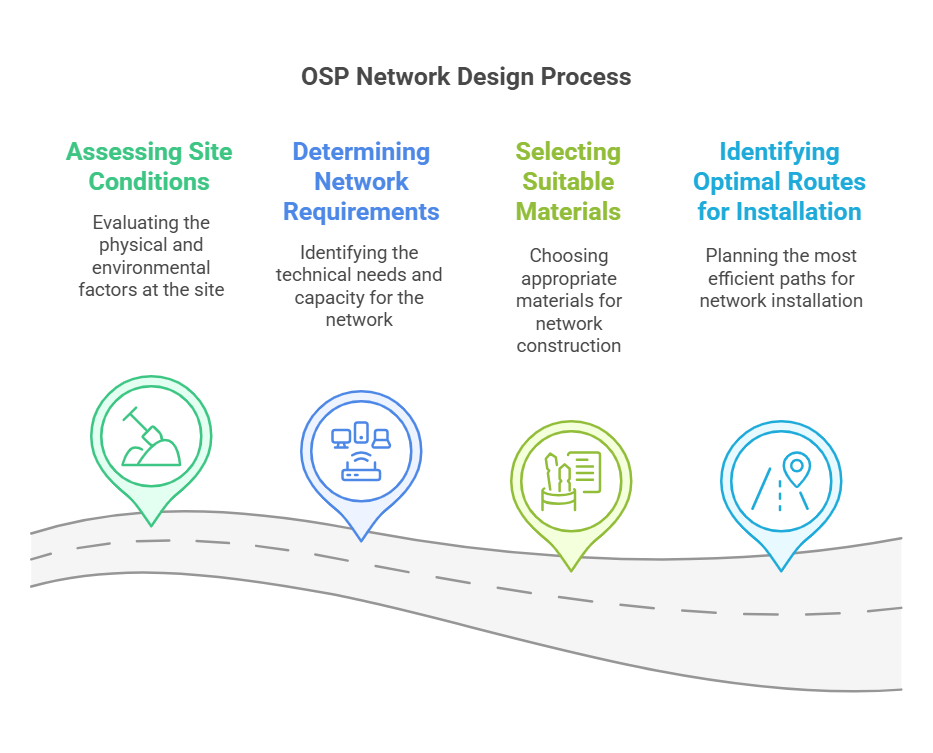Designing a robust, efficient, and scalable outside plant (OSP) network is the cornerstone of successful telecommunications infrastructure. Whether you’re expanding an existing network or planning a new one, careful design ensures optimal performance, minimal downtime, and future-proof scalability.
At DataField Technology Services, we specialize in crafting OSP network designs that combine innovative technologies, proven methodologies, and industry best practices to meet the unique needs of each project.
Our expert team leverages cutting-edge tools like GIS mapping and advanced network design software to deliver networks that stand the test of time and evolve with technological advancements. Let us guide you from blueprint to reality with a network designed for peak performance and growth.
OSP network design is a crucial process that involves planning and creating the layout and structure for an outside plant (OSP) network. This network infrastructure supports telecommunications systems by connecting various elements such as fiber optic cables, ducts, poles, and towers.
During the design phase, several factors must be considered, including:

By carefully addressing each of these elements, OSP network design sets the foundation for the network’s reliability, capacity, and long-term success. A well-executed design helps ensure the network can meet both current user demands and future expansions, minimizing the risk of costly changes or maintenance issues.
Effective OSP network design plays a pivotal role in determining the performance and scalability of the entire network.
Proper network design ensures not only current performance but also flexibility for the future. By anticipating future growth and technological advancements, a forward-thinking design protects your investment and provides the foundation for easy network expansion.
Fiber optic cables are the backbone of modern OSP networks. They enable fast and reliable data transmission, making them essential in high-performance networks.
When designing the network, several key considerations must be taken into account, including:
Ensuring that the fiber optic infrastructure is designed efficiently is critical to supporting high-speed data transfer and long-term network performance.
Before the network design is finalized, a thorough site survey must be conducted. This survey helps determine the most effective and efficient routes for fiber optic cables and network infrastructure. Several factors must be considered during the survey, such as:
By carefully considering these elements, designers can ensure that the network is installed in the most effective and sustainable way possible.
The architecture and topology of the network define how data flows and how resilient the network will be in case of failure. Some common network topologies include:
The chosen topology depends on factors such as the size of the network, the number of users, and the required level of redundancy and performance. A well-designed network architecture ensures both reliability and efficiency as the network scales.
Geographic Information Systems (GIS) have revolutionized the way OSP networks are designed. GIS mapping allows for the precise mapping of terrain, infrastructure, and environmental features, all of which are crucial when planning the routes for fiber optic cables and other network components.
The benefits of using GIS in OSP network design include:
By using GIS, designers can create a network layout that minimizes disruptions, reduces costs, and ensures efficient use of resources.

OSP network design relies on specialized software tools that streamline the process, enabling designers to create accurate and effective network blueprints. Some of the most commonly used design software includes:
These software tools enable engineers to quickly model and visualize their network designs, ensuring accuracy and reducing the risk of costly errors during installation.
Before an OSP network is built, simulations and testing are crucial for evaluating its performance and making any necessary adjustments. These tools help ensure that the network will meet performance goals and be optimized for future demands.
Key aspects of network simulation and testing include:
By using simulations and tests, designers can optimize the network’s layout and performance before construction begins, ensuring that the final installation is both cost-effective and reliable.
The landscape of OSP network design is evolving rapidly, with new technologies such as automation, artificial intelligence (AI), and the Internet of Things (IoT) playing an increasingly vital role in shaping the future of network infrastructure.
By embracing these technologies, OSP network designs can be more efficient, adaptable, and intelligent, enabling operators to meet current demands while planning for future challenges.
Sustainability has become a critical focus in OSP network design, with growing emphasis on minimizing environmental impact while maximizing the network’s potential for future expansion.
Sustainable and flexible designs provide a long-term solution, allowing OSP networks to evolve with future demands without the need for major redesigns or costly overhauls.
Designing an efficient OSP network requires navigating various physical, legal, and environmental challenges. Some of the most common obstacles include:
Successfully addressing these site constraints involves a comprehensive survey and flexible design planning that anticipates and mitigates potential obstacles, ensuring the project stays on track.
Budget constraints are a constant challenge in OSP network design. The design phase is critical for laying the foundation of a successful project, but it can be heavily influenced by financial considerations. Here’s how to manage these challenges:
Designers who proactively plan for budget constraints and resource limitations can make informed choices that ensure both cost-efficiency and long-term network performance.
A well-executed OSP network design can significantly reduce operational costs throughout the life of the network. Here’s how:
Ultimately, an efficient OSP design reduces both initial and long-term costs, making it a vital factor in the project’s overall success.
A critical component of any successful OSP network design is its ability to scale and adapt to future needs. The digital landscape is ever-evolving, and a network’s design must take this into account to ensure continued performance and relevance. Here’s how:
By considering scalability and flexibility in the initial design, businesses and service providers can ensure that their OSP network continues to perform at a high level long into the future, supporting both immediate goals and future growth.
When it comes to OSP network design, choosing the right partner is crucial for ensuring that your network is both reliable and scalable. At DataField Technology Services, we specialize in creating custom OSP network designs that meet the unique needs of each client, leveraging our deep industry expertise and innovative design practices. Here’s why you should consider DataField for your next OSP network design project:
DataField Technology Services has a strong history of delivering successful OSP network designs across a wide range of projects. Our experience spans various industries and sectors, and we’ve consistently exceeded client expectations by providing tailored solutions that address unique challenges. Here are a few examples of our proven success:
At DataField Technology Services, we are dedicated to providing you with the most efficient, reliable, and scalable OSP network designs tailored to your specific needs. Our team of experts is ready to work with you every step of the way, ensuring your network is set up for success now and in the future.
Whether you’re looking to expand your existing infrastructure or develop a new network from the ground up, DataField has the knowledge, experience, and tools to make your vision a reality.
